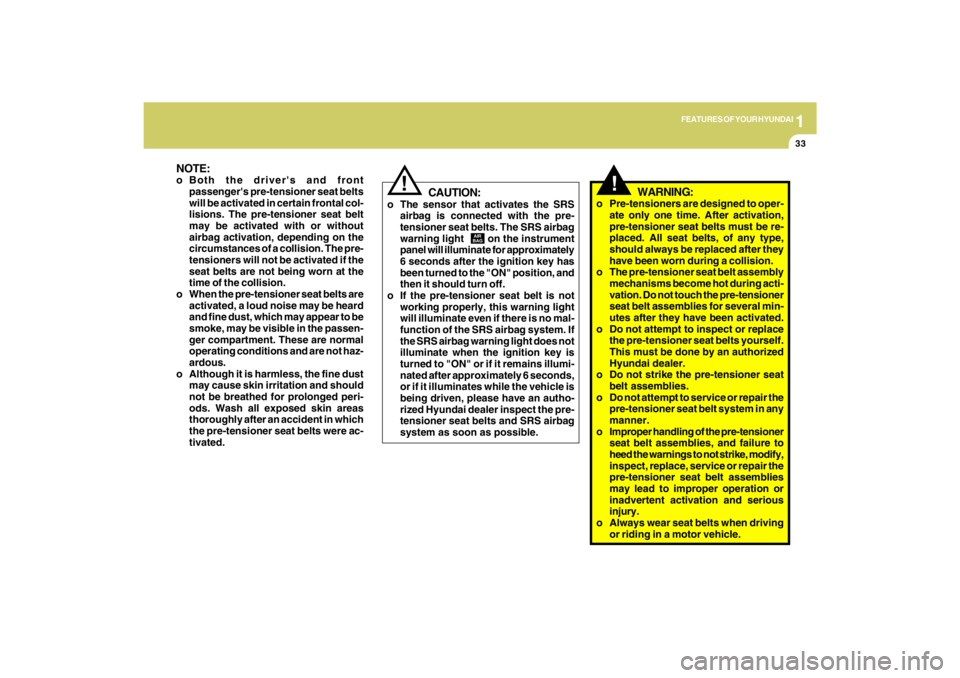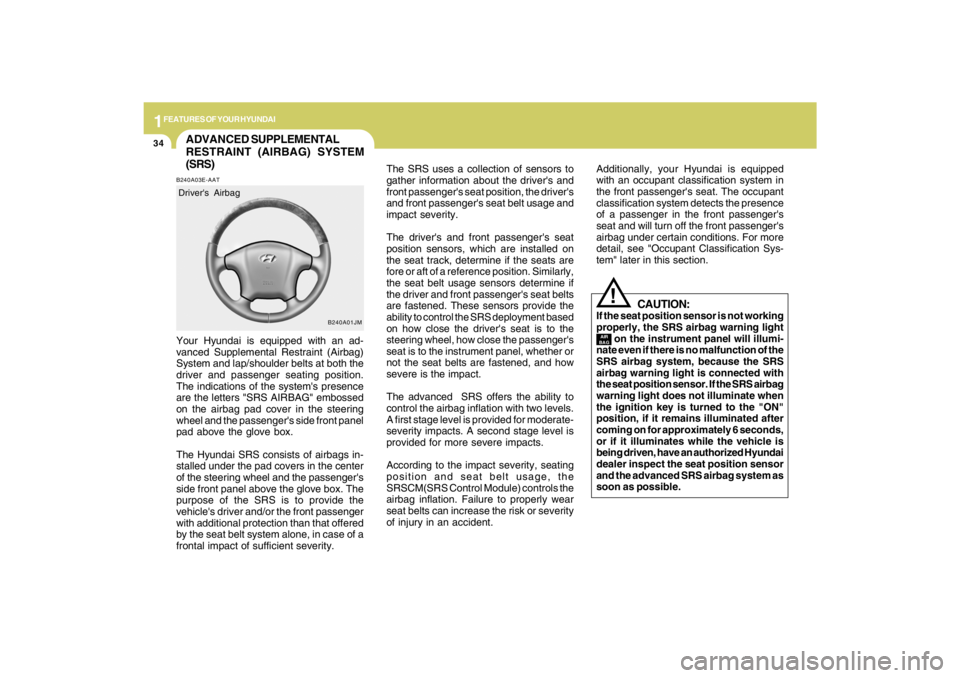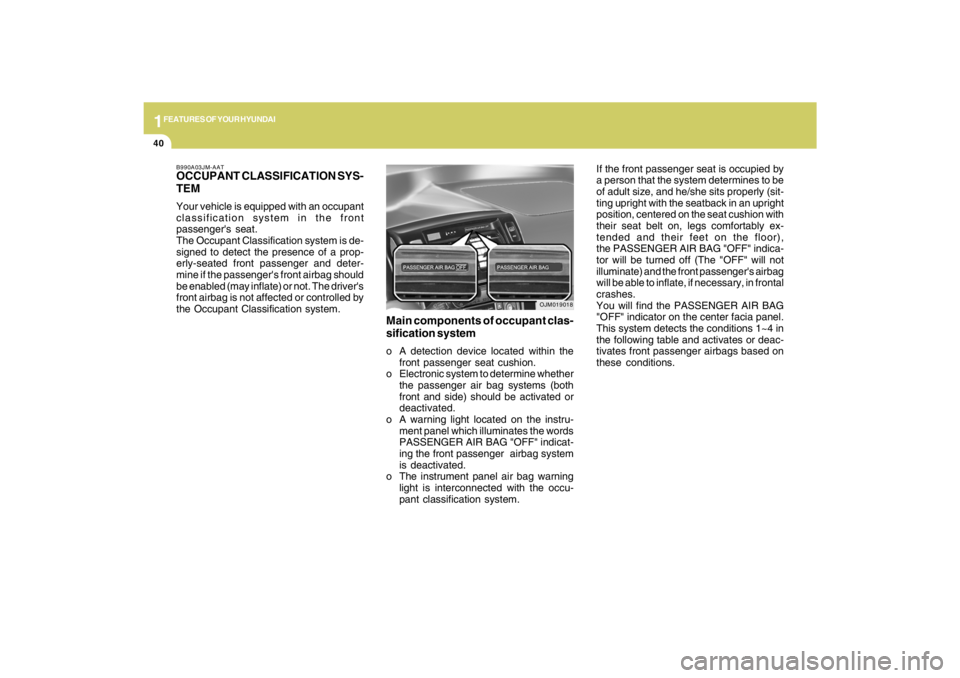2009 HYUNDAI TUCSON air condition
[x] Cancel search: air conditionPage 5 of 273

F4
A110A01A-AAT
VEHICLE DATA COLLECTION AND EVENT DATA RECORDERS
Your Hyundai vehicle is equipped with many high technology, electronically controlled systems
that help to ensure your vehicle operates properly and provides the performance that you
expect. These systems utilize computers to monitor the operation of various systems and
components and help to control their operation. These computerized system operations are
wide-ranging and involve components to reduce emissions, to continuously evaluate the
readiness of the airbag and seat belt pretensioner systems, to determine when the airbag and
seat belt pre-tensioner systems should be deployed and then to activate the deployment, and
if equipped, to operate anti-lock braking, traction control and electrical stability control to assist
the driver to control the vehicle in difficult driving situations. These systems electronically store
information that is useful to service technicians when they need to diagnose and repair these
systems. Additional information is stored only when a crash occurs that results in the
deployment of the airbags or seat belt pre-tensioners. This type of data storage is done by
devices called event data recorders(EDR).
After a crash event, the airbag and seat belt pre-tensioner computer system, known as the
Supplemental Restraint System Control Module (SRSCM) or Airbag Control Unit (ACU), may
record some information about the condition of the vehicle and how it was being operated. This
information consists of data related to seat belt usage and if there was diagnostic information
in the airbag or seat belt systems at the time that a crash occurred, and if the ACU sensed that
a crash of sufficient severity occurred to require seat belt pre-tensioner or airbag deployment.
To retrieve this information, special equipment is needed and access to the vehicle or the device
that stores the data is required. Hyundai will not access information about a crash event or share
it with others except:
o in response to an official request of police or similar government office, or
o with the consent of the vehicle owner or, if the vehicle is leased, with the consent of the lessee,
or
o as part of Hyundai’s defense of litigation, or
o as required by law.
Page 10 of 273

F9
1. Panel Brightness Control Knob (Rheostat Switch)
2. 4WD Lock Switch (If installed)
3. Traction Control System (TCS) Switch (If installed) /
Electronic Stability Control (ESC) Switch (If installed)
4. Instrument Cluster
5. Multi-Function Light Switch (If installed)
6. Front Window Defroster (If installed) / Aux Outlet (If
installed)
7. Hazard Warning Light Switch
8. Digital Clock
9. Windshield Wiper/Washer Switch10. Rear Defroster and Outside Rearview Mirror Heater Switch
(If installed)
11. Front Fog Light Switch (If installed)
12. Passenger's Airbag
13. Hood Release Lever
14. Horn and Driver's Airbag
15. Small Article Tray / Ashtray (If installed)
16. Cruise Control Switch (If installed)
17. Heating/Air Conditioning Control Panel (If installed)
18. Shift Lever (If installed)
19. Glove Box
CAUTION:
When installing a container of liquid air freshener inside the vehicle, do not place it near the instrument cluster
nor on the instrument panel surface. If there is any leakage from the air freshener onto these areas
(Instrument cluster, instrument panel or air ventilator), it may damage these parts. If the liquid from the air
freshener does leak onto these areas, wash them with water immediately.
!
Page 44 of 273

1
FEATURES OF YOUR HYUNDAI
33
!
WARNING:
o Pre-tensioners are designed to oper-
ate only one time. After activation,
pre-tensioner seat belts must be re-
placed. All seat belts, of any type,
should always be replaced after they
have been worn during a collision.
o The pre-tensioner seat belt assembly
mechanisms become hot during acti-
vation. Do not touch the pre-tensioner
seat belt assemblies for several min-
utes after they have been activated.
o Do not attempt to inspect or replace
the pre-tensioner seat belts yourself.
This must be done by an authorized
Hyundai dealer.
o Do not strike the pre-tensioner seat
belt assemblies.
o Do not attempt to service or repair the
pre-tensioner seat belt system in any
manner.
o Improper handling of the pre-tensioner
seat belt assemblies, and failure to
heed the warnings to not strike, modify,
inspect, replace, service or repair the
pre-tensioner seat belt assemblies
may lead to improper operation or
inadvertent activation and serious
injury.
o Always wear seat belts when driving
or riding in a motor vehicle.
CAUTION:
o The sensor that activates the SRS
airbag is connected with the pre-
tensioner seat belts. The SRS airbag
warning light on the instrument
panel will illuminate for approximately
6 seconds after the ignition key has
been turned to the "ON" position, and
then it should turn off.
o If the pre-tensioner seat belt is not
working properly, this warning light
will illuminate even if there is no mal-
function of the SRS airbag system. If
the SRS airbag warning light does not
illuminate when the ignition key is
turned to "ON" or if it remains illumi-
nated after approximately 6 seconds,
or if it illuminates while the vehicle is
being driven, please have an autho-
rized Hyundai dealer inspect the pre-
tensioner seat belts and SRS airbag
system as soon as possible.
!
NOTE:o Both the driver's and front
passenger's pre-tensioner seat belts
will be activated in certain frontal col-
lisions. The pre-tensioner seat belt
may be activated with or without
airbag activation, depending on the
circumstances of a collision. The pre-
tensioners will not be activated if the
seat belts are not being worn at the
time of the collision.
o When the pre-tensioner seat belts are
activated, a loud noise may be heard
and fine dust, which may appear to be
smoke, may be visible in the passen-
ger compartment. These are normal
operating conditions and are not haz-
ardous.
o Although it is harmless, the fine dust
may cause skin irritation and should
not be breathed for prolonged peri-
ods. Wash all exposed skin areas
thoroughly after an accident in which
the pre-tensioner seat belts were ac-
tivated.
AIR
BAG
Page 45 of 273

1FEATURES OF YOUR HYUNDAI34
ADVANCED SUPPLEMENTAL
RESTRAINT (AIRBAG) SYSTEM
(SRS)B240A03E-AATYour Hyundai is equipped with an ad-
vanced Supplemental Restraint (Airbag)
System and lap/shoulder belts at both the
driver and passenger seating position.
The indications of the system's presence
are the letters "SRS AIRBAG" embossed
on the airbag pad cover in the steering
wheel and the passenger's side front panel
pad above the glove box.
The Hyundai SRS consists of airbags in-
stalled under the pad covers in the center
of the steering wheel and the passenger's
side front panel above the glove box. The
purpose of the SRS is to provide the
vehicle's driver and/or the front passenger
with additional protection than that offered
by the seat belt system alone, in case of a
frontal impact of sufficient severity.
B240A01JM
Driver's Airbag
The SRS uses a collection of sensors to
gather information about the driver's and
front passenger's seat position, the driver's
and front passenger's seat belt usage and
impact severity.
The driver's and front passenger's seat
position sensors, which are installed on
the seat track, determine if the seats are
fore or aft of a reference position. Similarly,
the seat belt usage sensors determine if
the driver and front passenger's seat belts
are fastened. These sensors provide the
ability to control the SRS deployment based
on how close the driver's seat is to the
steering wheel, how close the passenger's
seat is to the instrument panel, whether or
not the seat belts are fastened, and how
severe is the impact.
The advanced SRS offers the ability to
control the airbag inflation with two levels.
A first stage level is provided for moderate-
severity impacts. A second stage level is
provided for more severe impacts.
According to the impact severity, seating
position and seat belt usage, the
SRSCM(SRS Control Module) controls the
airbag inflation. Failure to properly wear
seat belts can increase the risk or severity
of injury in an accident.
CAUTION:
If the seat position sensor is not working
properly, the SRS airbag warning light
on the instrument panel will illumi-
nate even if there is no malfunction of the
SRS airbag system, because the SRS
airbag warning light is connected with
the seat position sensor. If the SRS airbag
warning light does not illuminate when
the ignition key is turned to the "ON"
position, if it remains illuminated after
coming on for approximately 6 seconds,
or if it illuminates while the vehicle is
being driven, have an authorized Hyundai
dealer inspect the seat position sensor
and the advanced SRS airbag system as
soon as possible.
!AIR
BAGAdditionally, your Hyundai is equipped
with an occupant classification system in
the front passenger's seat. The occupant
classification system detects the presence
of a passenger in the front passenger's
seat and will turn off the front passenger's
airbag under certain conditions. For more
detail, see "Occupant Classification Sys-
tem" later in this section.
Page 51 of 273

1FEATURES OF YOUR HYUNDAI40
If the front passenger seat is occupied by
a person that the system determines to be
of adult size, and he/she sits properly (sit-
ting upright with the seatback in an upright
position, centered on the seat cushion with
their seat belt on, legs comfortably ex-
tended and their feet on the floor),
the PASSENGER AIR BAG "OFF" indica-
tor will be turned off (The "OFF" will not
illuminate) and the front passenger's airbag
will be able to inflate, if necessary, in frontal
crashes.
You will find the PASSENGER AIR BAG
"OFF" indicator on the center facia panel.
This system detects the conditions 1~4 in
the following table and activates or deac-
tivates front passenger airbags based on
these conditions.
OJM019018
Main components of occupant clas-
sification systemo A detection device located within the
front passenger seat cushion.
o Electronic system to determine whether
the passenger air bag systems (both
front and side) should be activated or
deactivated.
o A warning light located on the instru-
ment panel which illuminates the words
PASSENGER AIR BAG "OFF" indicat-
ing the front passenger airbag system
is deactivated.
o The instrument panel air bag warning
light is interconnected with the occu-
pant classification system.
B990A03JM-AATOCCUPANT CLASSIFICATION SYS-
TEMYour vehicle is equipped with an occupant
classification system in the front
passenger's seat.
The Occupant Classification system is de-
signed to detect the presence of a prop-
erly-seated front passenger and deter-
mine if the passenger's front airbag should
be enabled (may inflate) or not. The driver's
front airbag is not affected or controlled by
the Occupant Classification system.
Page 52 of 273

1
FEATURES OF YOUR HYUNDAI
41
!
*1) The system judges a person of adult
size as an adult. When a smaller adult
sits in the front passenger seat, the
system may detect him/her as a child
depending on his/her physique and
posture.
*2) When a larger child who has outgrown
a child restraint system sits in the pas-
senger seat, the system may detect
him/her as an adult depending on his/
her physique and posture.
*3) Never install a child restraint system on
the front passenger seat.
WARNING:
Riding in an improper position or placing
weight on the front passenger's seat
when it is unoccupied by a passenger
adversely affects the occupant classifi-
cation system (OCS).
Front
passenger
airbag
Activated
Deactivated
Deactivated
Deactivated Condition
detected by
the occupant
classification
system
1. Adult*
1
2. Child*
2 or
child restraint
system*3
3. Unoccupied
4. There is a
malfunction
in the
systemSRS
warning
light
Off
Off
Off
On
"PASSEN-
GER
AIR BAG
OFF"
indicator light
Off
On
On
On
Condition and operation in the front pas-
senger occupant classification system Always be sure that you and all vehicle
occupants are seated and restrained prop-
erly (sitting upright with the seat in an
upright position, centered on the seat cush-
ion, with the person's legs comfortably
extended, feet on the floor, and wearing
the safety belt properly) for the most effec-
tive protection by the air bag and the safety
belt.
o The OCS may not function properly if
the passenger takes actions which can
defect the detection system. These
include:
(1) Failing to sit in an upright position.
(2) Leaning against the door or center
console.
(3) Sitting towards the sides or the front
of the seat.
(4) Putting legs on the dashboard or
resting them on other locations which
reduce the passenger weight on the
front seat.
(5) Improperly wearing the safety belt.
(6) Reclining the seat back.
Page 55 of 273

1FEATURES OF YOUR HYUNDAI44
B990B02JM-AATSide Impact AirbagYour Hyundai is equipped with a side
impact airbag in each front seat. The pur-
pose of the airbag is to provide the vehicle's
driver and/or the front passenger with ad-
ditional protection than that offered by the
seat belt alone. The side impact airbags
are designed to deploy only during certain
side-impact collisions, depending on the
crash severity, angle, speed and point of
impact. The side impact airbags are not
designed to deploy in all side impact situ-
ations.
B990B02JM
!
WARNING:
o Do not sit on sharp objects such as
tools when occupying the front pas-
senger seat. This can adversely af-
fect the occupant classification sys-
tem.
o Do not use accessory seat covers on
the front seats.
o Accident statistics show that children
are safer if they are restrained in the
rear, as opposed to the front seat. It is
recommended that child restraints
be secured in a rear seat, including an
infant riding in a rear-facing infant
seat, a child riding in a forward-facing
child seat and an older child riding in
a booster seat.
o Airbags can only be used once – have
an authorized Hyundai dealer replace
the airbag immediately after deploy-
ment.
!
WARNING:
o A smaller-stature adult who is not
seated correctly (for example: seat
excessively reclined, leaning on the
center console, or hips shifted for-
ward in the seat) can cause a condi-
tion where the advanced frontal airbag
system senses less weight than if the
occupant were seated properly (sit-
ting upright with the seatback in an
upright position, centered on the seat
cushion with their seat belt on, legs
comfortably extended and their feet
on the floor). This condition can result
in an adult potentially being
misclassified and illumination of the
PASSENGER AIR BAG "OFF" indica-
tor.
Page 56 of 273

1
FEATURES OF YOUR HYUNDAI
45
!
WARNING:
WARNING:
o The side impact airbag is supplemen-
tal to the driver's and the passenger's
seat belt systems and is not a substi-
tute for them. Your seat belts must be
worn at all times while the vehicle is in
motion. The airbags deploy only in
certain side impact conditions severe
enough to cause significant injury to
the vehicle occupants.
!
HTB072
Side airbag
sensor
o For best protection from the side im-
pact airbag system and to avoid being
injured by the deploying side impact
airbag, both front seat occupants
should sit in an upright position with
the seat belt properly fastened. The
driver's hands should be placed on
the steering wheel at the 9:00 and
3:00 o'clock positions. The
passenger's arms and hands should
be placed on their laps.
o Do not use any accessory seat covers.
o Use of seat covers could reduce or pre-
vent the effectiveness of the system.
o Do not install any accessories on or
near the side impact airbag.
o Do not place any objects over the airbag
or between the airbag and yourself.
o Do not place any objects (an umbrella,
bag, etc.) between the front door and
the front seat. Such objects may be-
come dangerous projectiles and
cause injury if the supplemental side
impact air bag inflates.
o To prevent unexpected deployment of
the side impact air bag that may result
in personal injury, avoid impact to the
side airbag sensor when the ignition
key is on.
B990C01LZ-GATCurtain AirbagCurtain airbags are located along both
sides of the roof rails above the front and
rear doors.
They are designed to help protect the
heads of the front seat occupants and the
rear outboard seat occupants in certain
side impact collisions.
The curtain airbags are designed to de-
ploy only during certain side impact colli-
sions, depending on the crash severity,
angle, speed and impact. The curtain
airbags are not designed to deploy in all
side impact situations, collisions from the
front or rear of the vehicle or in most rollover
situations.
HJM2056
Curtain Airbag